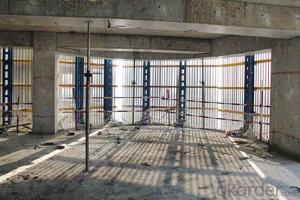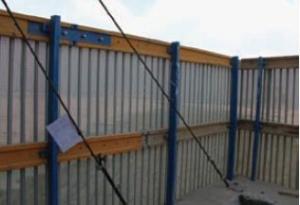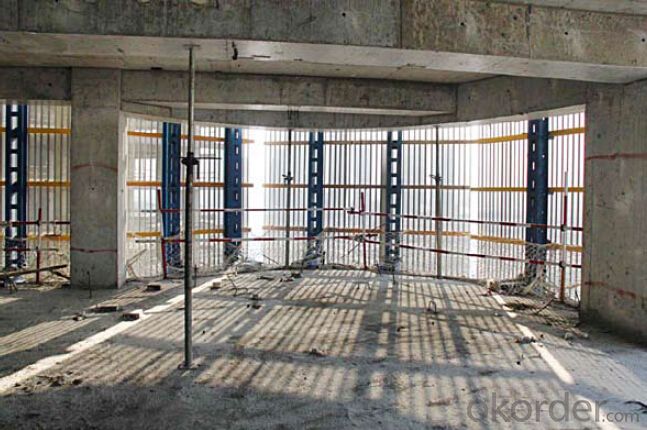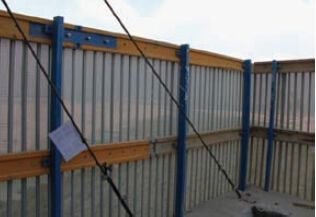Protection-Platform for Formwork and scaffolding systems
- Loading Port:
- Tianjin
- Payment Terms:
- TT OR LC
- Min Order Qty:
- 50 m²
- Supply Capability:
- 1000 m²/month
OKorder Service Pledge
OKorder Financial Service
You Might Also Like
Protection Platform PP-50
A kind of new type construction protection system, applying operating platform and safer job
location for construction corps.
Characteristics:
◆ Easy and quick assembling.
◆ Lifted as a group, it is rapid and economic.
◆ Auto-climbing
◆ A safe and reliable anchor system
1. Composition
2. Assembly process of anchor system
(1) Embed V-climbing cone and anchor plate into the slab.
(2) Fix anchor shoe on the slab by tensile bolt.
(3) The fixed anchor shoe.
◆ High work efficiency with work platform and unload platform
◆ High light transmittance with the hollow block
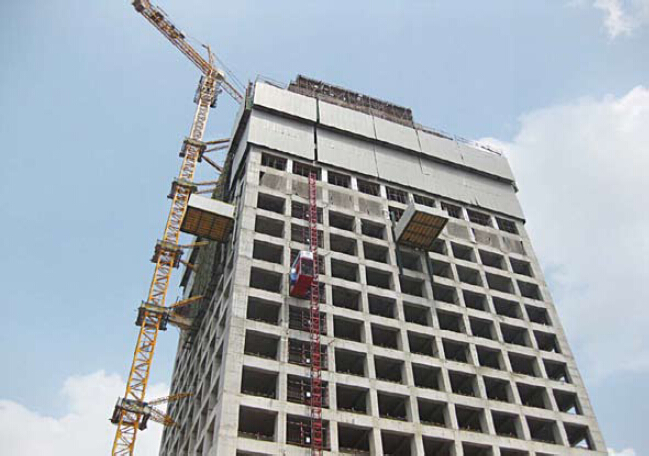

- Q: Are there any specific considerations for using steel formwork in earthquake-prone areas?
- In earthquake-prone areas, there are specific factors to consider when using steel formwork. Steel formwork is preferred in seismic regions due to its strength and durability. However, certain aspects need to be taken into account: 1. Flexibility is crucial. Steel formwork must be designed to withstand seismic forces and absorb and dissipate energy during an earthquake to minimize structural damage. 2. Connection details must be carefully engineered to ensure proper load transfer and resistance to seismic forces. Special attention should be given to joints and connections to prevent failure during an earthquake. 3. Additional reinforcement may be necessary to enhance the strength and stiffness of the steel formwork system. This can include extra steel bars, cross bracing, or diagonal struts to resist lateral forces. 4. Proper anchorage of the steel formwork is vital in earthquake-prone areas. It should be securely anchored to the foundation or structural elements to prevent displacement or movement during an earthquake. 5. Regular inspection and maintenance of the steel formwork system are essential in earthquake-prone areas. Any damage or wear should be promptly identified and repaired to maintain the system's integrity and stability. 6. Compliance with local building codes and regulations for seismic design is crucial. These codes provide guidelines and requirements for the design, installation, and use of formwork in earthquake-prone areas. By considering these specific factors, the use of steel formwork in earthquake-prone areas can enhance structural resilience and contribute to the overall safety and durability of construction projects.
- Q: How does steel formwork affect the overall structural integrity of a building?
- The overall structural integrity of a building is heavily reliant on steel formwork. During the construction process, steel formwork is used as a temporary mold or framework to shape and support concrete until it hardens and gains enough strength to bear its own weight and other applied loads. One of the main benefits of steel formwork is its superior strength and durability in comparison to other types of formwork like wood or plastic. Steel possesses high tensile strength and resistance to deformation, enabling it to withstand the pressure exerted by wet concrete without significant distortion. This strength ensures that the formwork maintains its shape and stability throughout the pouring and curing of concrete, preventing any potential collapse or failure that could compromise the building's structural integrity. Moreover, the use of steel formwork delivers precise and accurate results in terms of dimension and shape, which is crucial for achieving the desired structural integrity. Steel formwork can be fabricated to exact specifications, allowing for tight tolerances and precise positioning of reinforcement, resulting in a more uniform and robust structure. This precision guarantees that the building can endure various external loads, such as wind, seismic forces, and live loads, without excessive deflection or deformation. Additionally, steel formwork offers excellent reusability, making it a cost-effective and sustainable choice for construction projects. Unlike other formwork types that may require frequent replacement, steel formwork can be used multiple times, reducing material waste and overall project costs. This reusability also contributes to the building's structural integrity, as the formwork is less prone to deterioration or degradation over time, ensuring consistent quality and performance. To summarize, steel formwork significantly enhances the overall structural integrity of a building by providing superior strength, precision, and durability. Its ability to withstand the pressure of wet concrete, maintain accurate dimensions, and resist external loads ensures the building's structural stability and safety. Furthermore, the reusability of steel formwork offers cost-effective and sustainable advantages, further contributing to the long-term structural integrity of the constructed building.
- Q: How does steel formwork handle concrete pump pressure?
- Steel formwork is highly durable and strong, allowing it to effectively handle concrete pump pressure. Its robust structure and rigidity help distribute and withstand the force exerted by the concrete pump, ensuring that the formwork maintains its shape and integrity during the pouring process. This enables the steel formwork to effectively contain and support the concrete, resulting in a successfully executed construction project.
- Q: What are the common safety precautions when working with steel formwork in high winds?
- Some common safety precautions when working with steel formwork in high winds include securing the formwork properly to prevent it from being blown away or unstable, regularly inspecting the formwork for any damage or weaknesses that may be exacerbated by the wind, using appropriate personal protective equipment (PPE) such as helmets and safety harnesses, and ensuring that workers are trained on how to safely work in high wind conditions. Additionally, it is important to monitor weather conditions and suspend work if winds become too strong to ensure the safety of workers.
- Q: How does steel formwork handle moisture and humidity?
- Steel formwork is highly resistant to moisture and humidity due to its non-porous nature. Unlike other materials, steel does not absorb water, preventing any damage caused by swelling, warping, or decay. Additionally, steel formwork is coated with protective layers, such as galvanization or epoxy, which further enhance its resistance to moisture and humidity, ensuring its durability and longevity.
- Q: Is steel formwork suitable for all types of construction projects?
- Steel formwork is a versatile and widely used construction material that is suitable for a variety of construction projects. However, it may not be suitable for all types of construction projects. Steel formwork offers several advantages such as durability, reusability, and high load-bearing capacity. It can be used for both large-scale and small-scale projects, including residential, commercial, industrial, and infrastructure projects. Steel formwork is particularly well-suited for projects that require a high degree of precision and quality finish, such as high-rise buildings, bridges, and tunnels. However, there are certain factors to consider when determining the suitability of steel formwork for a specific construction project. One important factor is the project's budget. Steel formwork tends to have a higher initial cost compared to other types of formwork materials such as timber or aluminum. Therefore, it may not be suitable for projects with tight budget constraints. Another factor to consider is the project's timeline. Steel formwork requires skilled labor and time for assembly, disassembly, and transportation. This may result in longer construction periods, which may not be feasible for projects with strict deadlines. The complexity of the project is also an important factor to consider. Steel formwork is highly adaptable and can be custom-made for specific project requirements. However, if the project involves irregular or complex shapes, it may be more challenging and time-consuming to construct steel formwork compared to other types of formwork materials. Additionally, the environmental conditions of the construction site should be taken into account. Steel formwork is durable and can withstand harsh weather conditions. However, it may not be suitable for projects in coastal areas or locations with high humidity, as steel is susceptible to corrosion. In conclusion, while steel formwork is suitable for a wide range of construction projects, its suitability should be evaluated on a case-by-case basis. Considerations such as budget, timeline, complexity of the project, and environmental conditions should be taken into account to determine if steel formwork is the most suitable choice for a specific construction project.
- Q: How does steel formwork affect the overall construction site organization?
- Steel formwork can have a significant impact on the overall organization of a construction site. Firstly, steel formwork is known for its durability and reusability, which means it can be used multiple times for different projects. This allows for better planning and scheduling of construction activities, as the availability of formwork is more predictable and reliable. Additionally, steel formwork is known for its precision and accuracy, which leads to better quality construction. This can result in fewer reworks and delays, as the formwork ensures that concrete is poured in the right place and to the correct dimensions. Consequently, the overall construction process becomes more efficient, allowing for better organization and coordination of various trades and activities on the site. Steel formwork also offers flexibility in design and construction. It can be easily adjusted and modified to accommodate changes in the project, such as alterations in the shape or size of concrete elements. This adaptability reduces the need for additional materials and resources, which can streamline the organization of the construction site and minimize waste. Furthermore, steel formwork is known for its strength and stability. This allows for taller and larger concrete structures to be constructed, which can have implications for the overall layout and organization of the site. For example, it may require additional crane or lifting equipment to handle the heavier and larger formwork components. This necessitates careful planning and coordination to ensure that the site is properly organized to accommodate these requirements. In summary, steel formwork positively impacts the overall organization of a construction site by providing durability, precision, flexibility, and strength. These attributes contribute to better planning, scheduling, and coordination of construction activities, resulting in improved efficiency, quality, and adaptability.
- Q: Can steel formwork be used for tunnel linings?
- Yes, steel formwork can be used for tunnel linings. Steel formwork is a versatile and durable solution that can be customized to fit the specific requirements of tunnel construction. It provides a strong and rigid structure, capable of withstanding the pressures and forces exerted by the surrounding ground and any potential water ingress. Steel formwork also offers the advantage of being reusable, making it a cost-effective option for tunnel linings. Additionally, steel formwork can be easily assembled and disassembled, allowing for efficient and timely construction of tunnel linings.
- Q: Can steel formwork be used for both horizontal and vertical structures?
- Yes, steel formwork can be used for both horizontal and vertical structures. Steel formwork is a versatile construction material that can be easily adjusted and reused, making it suitable for various types of structures. It provides excellent strength and stability, making it ideal for supporting heavy concrete loads in both horizontal and vertical applications. Steel formwork systems can be customized and assembled to meet the specific requirements of different construction projects, allowing for efficient and precise construction of both horizontal slabs and vertical walls. Its durability and resistance to wear and tear make it a reliable choice for long-term use in various construction applications.
- Q: How does steel formwork affect the overall construction site productivity?
- Steel formwork can greatly enhance the overall construction site productivity. Its robustness and durability allow for multiple reuses, reducing the need for frequent replacements and saving time and resources. The precise dimensions and smooth surfaces of steel formwork also contribute to faster assembly and disassembly, enhancing the efficiency of the construction process. Additionally, steel formwork enables the construction of complex structures with greater accuracy and consistency, resulting in reduced errors, rework, and delays. Overall, the use of steel formwork positively impacts productivity by streamlining operations, minimizing downtime, and improving construction quality.
Send your message to us
Protection-Platform for Formwork and scaffolding systems
- Loading Port:
- Tianjin
- Payment Terms:
- TT OR LC
- Min Order Qty:
- 50 m²
- Supply Capability:
- 1000 m²/month
OKorder Service Pledge
OKorder Financial Service
Similar products
Hot products
Hot Searches
Related keywords
